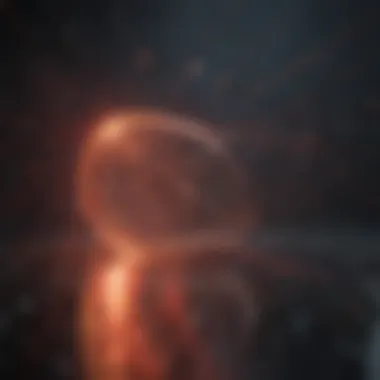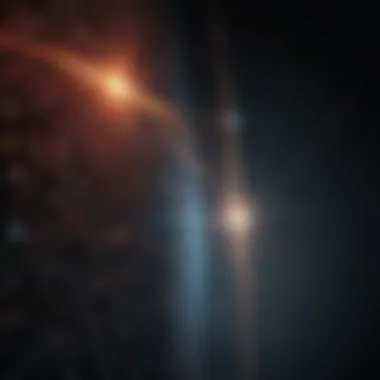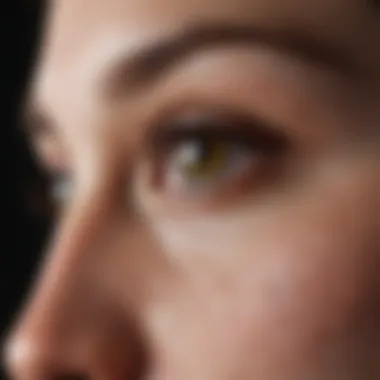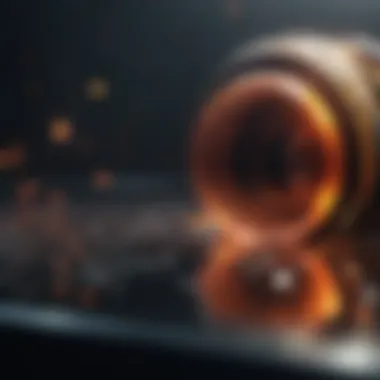Understanding Laser Speckle: A Deep Dive


Intro
Laser speckle is a phenomenon that surfaces from coherent light interacting with rough surfaces. It creates a unique pattern that scientists and researchers find both fascinating and useful. This article aims to dissect the intricacies surrounding laser speckle, its theoretical background, and its diverse applications across various fields such as imaging, metrology, and diagnostics. Understanding laser speckle not only enriches theoretical knowledge but also supports practical advancements in technology and science.
Overview of Research Topic
Brief Background and Context
Laser speckle can be described as a random granular pattern that appears when coherent light, like laser light, is scattered from a rough or textured surface. The original light beams interfere with each other, causing constructive and destructive interferences that result in a speckle pattern. While the phenomenon itself is often dismissed as mere noise in imaging systems, it actually offers valuable insights into material properties and can aid in various analytical processes.
Importance in Current Scientific Landscape
Understanding laser speckle holds significance in several scientific arenas. It has applications in industries ranging from medicine to materials science. In medical imaging, for example, laser speckle can help in analyzing blood flow in tissues or even detecting diseases in their early stages. Additionally, its role in metrology allows for precise measurements of surface flaws or topography. As laser technologies evolve, so does the relevance of understanding laser speckle better.
Methodology
Research Design and Approach
The exploration of laser speckle can follow various research designs, often grounded in experimental and theoretical frameworks. Researchers typically engage in both simulations and real-world experimentation to investigate the underlying principles of laser speckle formation.
Data Collection Techniques
Data collection methods for studying laser speckle involve both qualitative and quantitative analyses. Tools such as high-speed cameras capture speckle patterns for further assessment. Various techniques, including digital holography, may be employed to retrieve detailed information from these patterns, thereby allowing for advanced imaging and diagnostics.
"laser speckle can provide critical insights into material properties and dynamic processes that are otherwise difficult to measure."
As research into laser speckle continues, the possibilities for its applications seem endless. Understanding its nuances not only opens doors for innovation but also invites deeper inquiry into the behaviors of light and materials.
Preface to Laser Speckle
Laser speckle is a nuanced phenomenon that emerges from the interference of coherent light scattered by a rough surface. It plays a crucial role in various scientific and engineering fields, such as optics, imaging, and diagnostics. Understanding laser speckle is key to mastering a multitude of applications ranging from medical diagnostics to quality control in manufacturing. The significance of this topic extends further, impacting research and innovation across multiple disciplines. As the capabilities of laser technology advance, the importance of understanding laser speckle increases, making this an essential aspect of modern science.
Defining Laser Speckle
Laser speckle can be defined as a granular pattern that occurs when coherent light, typically from a laser, interacts with a rough or textured surface. This interaction causes variations in light intensity, resulting in a distinct pattern of light and dark spots known as a speckle pattern. The randomness of these patterns is a direct consequence of the interference of multiple waves reflected off the surface. The key characteristics of laser speckle include:
- Coherence: The light's phase relationship must remain stable for speckle patterns to form.
- Surface Roughness: The texture of the surface affects the complexity and visibility of the speckle pattern.
- Scattering: Higher degrees of scattering lead to more intense speckle patterns.
Understanding these factors is vital for scientists and engineers when utilizing laser speckle in practical applications.
Historical Context and Developments
The study of laser speckle is rooted in the development of coherent light sources, primarily lasers, in the mid-20th century. Early investigations focused on the fundamental principles of light interference and scattering. Notably, the 1960s saw the first use of laser speckle in practical applications, particularly in the field of metrology. Researchers like W. M. McGowan and H. S. McEwen played key roles in establishing the foundational theories related to spatial coherence and the statistical analysis of speckle patterns.
Over the years, advancements in laser technology and digital imaging have allowed researchers to manipulate and analyze speckle patterns with greater precision. Key developments include:
- Improved Laser Sources: The introduction of diverse laser types has enhanced experimental flexibility.
- Digital Signal Processing: This technology has improved the analysis of speckle patterns, allowing for better interpretation of the data.
- Application Expansion: The use of laser speckle has broadened to include various fields such as biology, materials science, and optical engineering, showcasing its versatility.
The evolution of laser speckle phenomena has opened new frontiers for research and practical applications alike.
In summary, understanding laser speckle involves grasping its definitions, historical context, and the significant technological developments that have shaped its application. The intricate nature of this phenomenon will be explored in further sections, enhancing our comprehension of its underlying physics and practical uses.
The Physics of Laser Speckle
The exploration of laser speckle is deeply rooted in the physics of light, particularly the phenomena of interference and coherence. Understanding the physics behind laser speckle is crucial, as it serves as the foundation for its applications in various fields such as imaging, diagnostics, and material analysis. The nuances of laser speckle extend beyond aesthetic patterns; they embody complex signals that arise from coherent light interacting with rough surfaces or inhomogeneous media.


Through a detailed investigation into the mechanisms of light interference and the role of coherence length, one can grasp how various experimental setups exploit these principles to yield valuable data.
Mechanisms of Light Interference
The core of laser speckle originates from the principle of light interference. When coherent light, such as that from a laser, strikes a rough surface, it scatters in multiple directions. Each of these scattered beams can interfere with the others, leading to the formation of a speckle pattern.
These interference mechanisms are fundamentally influenced by the phase differences between the light waves. If two waves meet in phase, they reinforce each other, resulting in brighter spots. Conversely, if they meet out of phase, they cancel each other out, resulting in dark areas in the pattern. This creates a random pattern of bright and dark spots, known as a speckle. The complexity of these patterns is a direct reflection of the surface texture and the coherence properties of the light used.
Factors that affect interference include:
- Surface Roughness: The degree of roughness intricately alters the scattering behavior.
- Wavelength of Light: Different wavelengths will behave uniquely when interacting with surfaces.
- Angle of Incidence: The angle at which the light strikes the surface can influence the interference results.
Understanding these mechanisms aids researchers in analyzing complex materials and involves statistical approaches to decipher the information contained within the speckle patterns. For instance, in fields such as biomechanics, these patterns can provide insights into blood flow and tissue movement during diagnostic imaging.
Role of Coherence Length
The concept of coherence length is pivotal in determining the quality and stability of laser speckle patterns. Coherence length refers to the distance over which a coherent light wave maintains a predictable phase relationship. It is determined by the spectral width of the light source: narrower spectral widths lead to longer coherence lengths.
In laser speckle studies, maintaining a suitable coherence length is essential for the formation of distinguishable speckle patterns. If the coherence length is too short relative to the path differences in the scattered light, the resulting speckle pattern will be weak and less informative.
Key considerations regarding coherence length include:
- Spectral Width of the Laser: A laser with a narrow spectral output achieves high coherence length, essential for generating sharp and clear speckle patterns.
- Environmental Factors: Changes in temperature, pressure, and other environmental characteristics can affect the coherence of light, hence influencing the speckle feature.
Consequently, the selection of light sources in laser speckle imaging must be carefully considered. Utilizing suitable lasers can enhance the effectiveness of this technology in applications like medical diagnostics and industrial inspections.
Understanding the intricate physics of laser speckle not only helps in practical applications but also pushes forward research in diverse fields, from optical engineering to healthcare.
Mathematical Modeling of Laser Speckle
Mathematical modeling of laser speckle is integral to understanding and harnessing this phenomenon. It enables researchers to predict speckle patterns and analyze their underlying properties. Moreover, mathematical models provide essential insights for various applications, including imaging and diagnostics. By employing these models, one can simulate the behavior of coherent light interacting with rough surfaces, thereby elucidating the characteristics of the resulting speckle patterns.
Statistical Properties of Speckle Patterns
The statistical properties of speckle patterns are foundational in comprehending their behavior. Speckle patterns emerge from the interference of multiple light waves scattered by a rough surface. Their intensity distribution can often be modeled using statistical functions. Commonly, the Rayleigh distribution applies, describing the variation in intensity between different random speckle spots. The analysis of these properties can inform researchers about the surface characteristics of the object being illuminated.
Important statistical aspects include:
- Mean intensity: Represents the average brightness over the speckle pattern.
- Variance: Measures how much intensity values differ from the mean.
- Auto-correlation function: Analyzes the similarity of the speckled pattern at different points or times.
Understanding these properties aids in extracting meaningful information from images captured using laser speckle techniques. For example, one can infer structural details and surface roughness from the statistical distribution of the speckle intensities.
Computational Approaches for Analysis
Computational methods play a crucial role in the analysis of laser speckle. These techniques are essential as the complexity of speckle patterns increases. Engineers and researchers utilize various algorithms and software tools to model and interpret speckle data effectively.
Several approaches include:
- Monte Carlo simulations: These allow for the generation of realistic speckle patterns based on random distributions of scatterers.
- Digital signal processing: Techniques such as Fast Fourier Transform help analyze speckle patterns in the frequency domain.
- Machine learning models: Increasingly, researchers apply these to identify patterns and improve predictions further.
Implementing these computational strategies enables precise analysis of laser speckle data. Consequently, this enhances the effectiveness of applications across several fields, from medical diagnostics to material analysis.
"The application of computational theories significantly expands the potential uses of laser speckle technology, making it a vital tool in modern science and engineering.”
In summary, the mathematical modeling of laser speckle covers statistical properties and computational approaches. These concepts are key to unveiling the complexities of laser speckle and utilize it effectively.


Applications in Imaging
Laser speckle presents varied applications in imaging disciplines, showcasing its potential to capture information with high sensitivity and resolution. Its unique properties arise from coherent light scattering, leading to intricate patterns that inform different areas of research and practical use. This section aims to explore the specific elements of laser speckle applications, their benefits, and essential considerations.
Laser Speckle Contrast Imaging
Laser Speckle Contrast Imaging (LSCI) is a notable technique leveraging the dynamics of laser speckle patterns to provide insight into blood flow and microcirculation. LSCI operates on the principle that moving particles alter speckle patterns in ways that can be quantified. This innovative approach allows researchers to derive critical parameters related to blood flow without requiring invasive procedures. The advantages of LSCI include
- Non-invasiveness: Unlike traditional methodologies, LSCI allows for real-time imaging without physically penetrating tissues.
- Real-time Monitoring: The dynamic nature of laser speckle offers continuous data, ideal for assessing changing physiological conditions.
- High Spatial Resolution: The ability of LSCI to produce detailed images makes it suitable for applications in small animal models and localized studies.
However, challenges persist, including noise interference and varying light conditions affecting image quality. Researchers must account for these factors to ensure that data interpretation remains reliable and valid.
Benefits in Medical Diagnostics
The benefits of laser speckle in medical diagnostics are significant. This technique's ability to visualize blood flow can aid in diagnosing several conditions, including vascular issues and ischemic events. Laser speckle imaging can be integrated with existing diagnostic tools, providing an additional layer of information that enhances clinical decision-making.
Moreover, the speed and accuracy of diagnosis using laser speckle contribute to timely treatment interventions. It has been particularly effective in monitoring skin wounds and ulcers, where assessing perfusion is essential for healing. The integration of laser speckle methodologies in medical diagnostics indicates a shift towards more holistic, real-time patient assessments.
Role in Non-Destructive Testing
In the field of non-destructive testing (NDT), laser speckle plays a crucial role. NDT employs various techniques to assess materials and structures without causing damage. Laser speckle’s sensitivity to displacement and strain makes it a valuable tool for detecting fault lines and other structural deficiencies.
Some notable aspects of using laser speckle in NDT include:
- Detection of Subsurface Flaws: By analyzing speckle patterns, inspectors can identify imperfections beneath the surface of materials.
- Robustness and Flexibility: Laser speckle techniques can be adapted for various materials, making NDT applicable across industries such as aerospace, construction, and manufacturing.
- Cost-Effectiveness: The efficiency of laser speckle methodologies can lead to reduced operational costs through fewer material failures and enhanced quality control.
Laser speckle imaging is an innovative approach across disciplines, highlighting how coherent light can provide crucial insights into both biological and material systems.
In summary, the application of laser speckle across imaging, medical diagnostics, and non-destructive testing demonstrates Versatility and efficacy. As these technologies evolve, their contributions to various fields enhance our understanding and management of complex systems.
Advancements in Laser Speckle Technologies
The field of laser speckle has seen significant advancements in recent years. These innovations have expanded the scope and utility of laser speckle techniques, making them essential in various professional domains. By improving how we generate and analyze speckle patterns, researchers and practitioners can achieve more accurate and reliable outcomes in their studies and applications. This section discusses the emergence of new laser sources and the innovations in detection technologies that enhance the effectiveness of laser speckle.
Emerging Laser Sources
The development of new laser sources greatly impacts the quality and applicability of laser speckle imaging. Traditional laser systems often pose limitations in terms of coherence length, stability, and spectral properties. However, emerging laser technologies are addressing these issues directly, facilitating greater precision in speckle measurement.
Recent advancements include the introduction of fiber lasers and semiconductor lasers, which offer unique benefits.
- Increased Stability: Fiber lasers are known for their stability and efficiency, reducing noise and enhancing signal quality. This stability is vital when capturing speckle patterns.
- Broadwavelength Ranges: Semiconductor lasers provide the advantage of tunable wavelengths. This allows for optimization according to the specific requirements of different applications, like medical imaging or industrial inspections.
- Compact Design: New lasers often come in more compact forms, making them easier to integrate into existing setups without significant redesign.
Much research is ongoing to improve laser sources further, including attempts to reduce the speckle size and improve spatial coherence. These advancements promise to make laser speckle imaging more applicable in fields such as biology and materials science.
Innovations in Detection Technologies
Alongside advancements in laser sources, detection technologies have also evolved. These technological improvements have made significant contributions to data acquisition and the analysis of laser speckle patterns.
Modern detection systems often utilize high-speed cameras and specialized sensors that are finely tuned to capture laser speckle effectively. Here are some key innovations:
- High-Resolution Cameras: The advent of high-resolution cameras has enhanced the detail captured in speckle patterns. This resolution enables researchers to extract more data and gain deeper insights into the tested materials.
- Real-Time Processing: With advancements in computing technology, real-time image processing is now feasible. This allows immediate analysis of speckle patterns, which can be crucial in clinical settings or dynamic environments.
- Integration with Other Technologies: Newer detection systems often come equipped with software that enables the integration of speckle data with other imaging modalities, such as MRI or optical coherence tomography. This multi-modal approach leads to more comprehensive assessments in medical diagnostics and research.
"New advancements in laser speckle technologies create opportunities for more precise and reliable data across scientific disciplines."
Challenges in Laser Speckle Studies


The study of laser speckle presents various challenges that researchers must navigate. These challenges can significantly impact the above methodologies, data quality, and subsequently the conclusions drawn. Understanding these roadblocks is essential for any meaningful progress in this field.
Interference from Environmental Factors
Environmental factors can have a large impact on the behavior of laser speckle. For instance, fluctuations in temperature can alter the refractive index of the medium through which the laser beam travels. This change can disrupt the path and coherence of light waves, leading to variations in speckle patterns.
- Vibrations: Mechanical vibrations in the environment can also change the orientation or position of the scattering surface. The result is a speckle pattern that fluctuates over time, complicating the interpretation of images.
- Ambient Light: The presence of ambient light can interfere with measurements, reducing contrast and making it harder to discern the data. Researchers must often work in dark environments or use filters to minimize this effect.
- Humidity: Changes in humidity can affect the scattering medium as well, leading to unpredictable variations in the speckle patterns.
These factors necessitate careful control of experimental conditions. Failure to account for even minor environmental changes can result in inaccurate data and misleading interpretations.
Limitations in Data Interpretation
Data interpretation in laser speckle studies requires a nuanced understanding of both the theory and practice behind the technology. Several limitations can impede effective analysis.
First, the statistical properties of speckle patterns can lead to misinterpretation if used inappropriately. For instance, a common method involves using contrast measures from speckle patterns, but this depends heavily on the homogeneity of the scattering surface. If there are any irregularities, the results can be skewed.
Additionally, processing algorithms used for image reconstruction can introduce their own biases. The accuracy of these algorithms is paramount. If the underlying assumptions are flawed, resulting data becomes unreliable.
- Resolution Limits: High-frequency noise and limitations in sensor resolution can hinder the capturing of accurate speckle patterns.
- Dynamic Changes: Instantaneous changes in the object being measured can result in transient speckle patterns, making consistent measurements challenging.
- Complexity of Analysis: The mathematical models used for analyzing speckle patterns often face limitations. They may not accurately account for all potential variables in real-world applications.
Given these challenges, it is vital to integrate multidisciplinary approaches and advanced computational techniques to enhance the robustness of data analysis. By doing so, researchers can develop a more profound understanding of laser speckle and its applications.
Future Directions in Research
The investigation of laser speckle represents a compelling path forward in both fundamental science and practical applications. As researchers continue to explore the complexities of this phenomenon, new methodologies emerge, offering the potential for advancements across various sectors. Understanding the future directions of this research is vital as it encompasses innovations that can harness laser speckle more effectively.
In particular, attention to emerging technologies and interdisciplinary approaches in this field bears significant implications. The integration of non-traditional sciences into laser speckle research can yield comprehensive strategies, leading to enhanced analysis and utilization.
Integration with Artificial Intelligence
The interplay of artificial intelligence (AI) and laser speckle analysis is proving to be a transformative direction. AI has the potential to analyze large datasets resulting from laser speckle imaging swiftly. This integration can lead to more accurate interpretations of speckle patterns, assisting in real-time diagnostics and decision-making processes.
Moreover, machine learning algorithms can be trained using vast amounts of data, improving their ability to identify subtle changes within speckle patterns that would be invisible to the human eye. This capability expands the scope of laser speckle applications into new realms, such as personalized medicine and advanced materials characterization. As an example, AI can optimize imaging parameters dynamically, ensuring maximum resolution and clarity in findings.
Interdisciplinary Approaches
An interdisciplinary approach amplifies the research landscape of laser speckle. Collaboration among physicists, engineers, computer scientists, and health professionals fosters innovation. By sharing insights and methodologies, these diverse fields can tackle the intricacies of laser speckle phenomena more effectively.
For instance, advancements in optical engineering can lead to improved laser systems that produce more coherent light, enhancing the quality of speckle patterns obtained in imaging. In parallel, insights from biomedical research enable a deeper understanding of how these patterns can be utilized in medical diagnostics.
Interdisciplinary collaboration enhances problem-solving capabilities and fosters innovation by bridging gaps between various domains.
Additionally, combining knowledge from various disciplines can yield novel applications such as laser speckle in environmental monitoring or security screening. This wide-ranging collaboration suggests that the future of laser speckle research is not just limited to optics; it can reshape our approach to significant global challenges.
Culmination
Understanding laser speckle fundamentally enhances various fields of research and application. Its relevance spans numerous domains, resulting from the distinctive interplay of coherent light with rough surfaces. This article encapsulates the pivotal elements that contribute to the comprehension of laser speckle, which includes the theoretical frameworks, mathematical models, and technological advancements.
Summary of Key Findings
The exploration of laser speckle revealed several critical insights. Firstly, it is anchored in the principles of light interference. The coherent nature of laser light interacting with microscopic surface irregularities generates unique speckle patterns. These patterns are not mere optical artifacts; they hold valuable information about the surface characteristics and environmental conditions. The statistical properties of these patterns facilitate various practical applications, particularly in imaging techniques like Laser Speckle Contrast Imaging, which has been instrumental in medical diagnostics.
Furthermore, developments in detection technologies and computational methodologies have expanded the applicability of laser speckle. New laser sources support advanced imaging systems, while innovative data analysis tools provide deeper insights into speckle patterns. As challenges persist, particularly stemming from environmental interference and data interpretation barriers, ongoing refinement in research is vital.
Implications for Future Research
The future of laser speckle research is promising and multifaceted. One significant direction is the integration of artificial intelligence, which can enhance pattern recognition and data interpretation. Machine learning techniques can process complex data sets, potentially unveiling otherwise obscured patterns critical for diagnostics and measurement. This intersection of laser speckle and AI may lead to breakthroughs in real-time imaging and enhanced accuracy in diagnostic results.
Moreover, interdisciplinary approaches that merge optics with fields like material science and biomedical engineering can yield innovative solutions for existing challenges. The adaptability of laser speckle techniques positions it well for advancements, especially in the context of non-destructive testing and precision metrology.
In summary, understanding laser speckle not only elucidates a complex optical phenomenon but also paves the way for future innovations across various disciplines. The ongoing commitment to exploration in this area will contribute to significant technological and scientific advancements.



